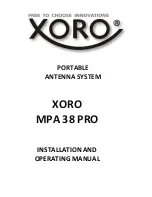
System Overview
QB.11-R Installation and Management
Changing Basic Configuration Information
39
NOTE:
Because DFS may need to scan for radar on multiple channels, you must allow a sufficient amount of time for the
units to start up. This is considerably longer than when the unit is not using DFS. This is expected behavior.
Startup time is within four minutes if no radar is detected, but up to one minute is added for every selected
channel that results in radar detection.
DFS is required for three purposes:
1.
Radar avoidance both at startup and while operational
. To meet these requirements, the BSU scans available
frequencies at startup. If a DFS-enabled channel is busy or occupied with radar, the system will blacklist the channel
for a period of 30 minutes in accordance with FCC, IC, and ETSI regulations. Once fully operational on a frequency,
the BSU actively monitors the occupied frequency. If interference is detected, the BSU blacklists the channel, logs a
message and rescans to find a new frequency that is not busy and is free of radar interference.
Radar detection is performed only by the BSU and not by the SU. When an SU is set to a country in which DFS is
used, it scans all available channels upon startup looking for a BSU that best matches its connection criteria (such as
Base Station System Name
,
Network Name
, and
Shared Secret
). The SU connects to the BSU automatically on
whatever frequency the BSU has selected. Because of this procedure, it is best to set up the BSU and have it fully
operational before installing the SU, although this is not required. If a BSU rescans because of radar interference, the
SU loses its wireless link. The SU waits 30 seconds (when the Mobility feature is enabled, the SU starts scanning for
a BSU instantly rather than waiting 30 seconds); if it finds that it could not receive the BSU in this amount of time, it
rescans the available frequencies for an available BSU.
2.
Guarantee the efficient use of available frequencies by all devices in a certain area
. To meet this requirement, the
BSU scans each available frequency upon startup and selects a frequency based upon the least amount of noise and
interference detected. This lets multiple devices operate in the same area with limited interference. This procedure is
done only at startup; if another UNII device comes up on the same frequency, the BSU does not detect this or rescan
because of it. It is expected that other devices using these frequencies also are in compliance with country
regulations, so this should not happen.
3.
Uniform Channel Spreading.
To meet this requirement, the MP.11-R randomly selects operating channel from the
available channels with least interference. If the DFS Preferred Channel is configured, the unit begins by scanning
that channel. If no interference is detected, the unit makes this channel operational. If the channel is busy or occupied
by radar, the unit blacklists that channel and scans other available channels for the one with least interference. This
implements the Uniform Channel Spreading requirement by either automatically selecting the channel with least
interference or allowing the installer to manually select a channel with least interference from a channel plan.
Transmit Power Control
Transmit Power Control is a manual configuration selection to reduce the unit’s output power. The maximum output
power level for the operating frequency can be found in the event log
of the unit’s embedded software.
ATPC (Automatic Transmit Power Control) is a feature to automatically adapt transmit power when the quality of the link
is more than sufficient to maintain a good communication with reduced transmit power. This feature is required for FCC
DFS. It works by monitoring the quality of the link and reducing the output power of the radio by up to 6 dB when good link
quality can still be achieved. When link quality reduces, the output power is automatically increased up to the original
power level to maintain a good link. For a full discussion of DFS, see
Dynamic Frequency Selection (DFS)
above.
By default, the unit lets you transmit at the maximum output power that the radio can sustain for data rate and frequency
selected. However, with Transmit Power Control (TPC), you can adjust the output power of the unit to a lower level in
order to reduce interference to neighboring devices or to use a higher gain antenna without violating the maximum
radiated output power allowed for your country. Also, some countries that require DFS also require the transmit power to
be set to a 6 dB lower value than the maximum allowed EIRP when link quality permits, as part of the DFS requirements.
NOTE:
When the system is set to transmit at the maximum power, professional installers must ensure that the maximum
EIRP limit is not exceeded. To achieve this, they may have to add attenuation between the device and the
antenna when a high gain antenna is used.
For 4954-R models: to comply with FCC Part 90 regulations when using an external antenna, a TPC value of -3
dB is required regardless of antenna size, and a larger TPC value may be required to limit the total EIRP to 29
















































